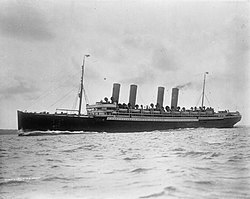


"First globalization" is a phrase used by economists to describe the world's first major period of globalization of trade and finance, which took place between 1870 and 1914. The "second globalization" began in 1944 and ended in 1971. This led to the third era of globalization, which began in 1989 and continues today.[1]
The period from 1870 to 1914 represents the peak of 19th-century globalization. First globalization is known for increasing transfers of commodities, people, capital and labour between and within continents. However, it is not only about the movement of goods or factors of production. First globalization also includes technological transfers and the rise of international cultural and scientific cooperation. The 1876 World Fair in Philadelphia was the first not to take place in Europe. The modern Olympics began in 1896. The first Nobel prizes were awarded in 1901.[2][3][4]
International trade grew for many reasons. Constant technological improvement and increased usage associated with the decline in international freight rates. The development of railways lowered the transport costs, which resulted in a massive migration within Europe and from the Old World to the New World. Exchange-trade stability and reduction of uncertainty in trade made possible by the gold standard. Peace between main powers and reduction of trade barriers promoted trade.[2][3][4]
1870-1914 is also known as the laissez-faire period, thus mostly liberal international policies are in place. However, the trade policies of the time lacked reciprocity.[3]
This period saw financial crises comparable to those of the late twentieth and early twenty-first centuries and the end of the First globalisation is associated with the collapse of international trade when World War I. started.[3]
- ^ Piketty, Thomas (2014). Capital in the Twenty First Century. Translated by Goldhammer, Arthur. Cambridge, Mass.: Belknap Press: An Imprint of Harvard University Press. ISBN 9780674430006.
- ^ a b Morys, Matthias (June 2008). "Globalization, 1870-1914". ResearchGate.
- ^ a b c d "Learning from the first globalisation (1870-1914)". Trésor-Economics. October 2011.
- ^ a b Estevadeordal, Antoni; Frantz, Brian; M. Taylor, Alan (February 2002). "The Rise and Fall of World Trade, 1870−1939" (PDF).
{{cite web}}: CS1 maint: multiple names: authors list (link)